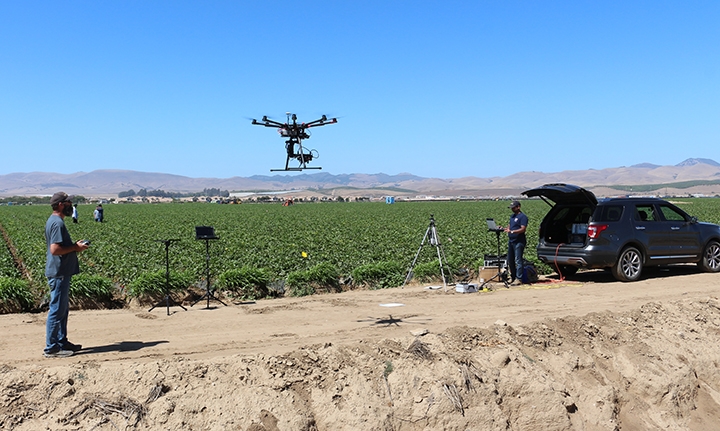Dec 18, 2019Drones impact modern sustainable ag
Drones…
If you’re thinking of apiculture, you might be thinking of drones (male bees).
But if you’re thinking of agriculture – more specifically sustainable agriculture practices in the 21st century – you ought to be thinking of the importance of unmanned aerial robots.


These drones promise to have a huge impact on 21st century sustainable agriculture.
Indeed, a newly published review paper, “Drones: Innovative Technology for Use in Precision Pest Management,” appearing in the Journal of Economic Entomology, should be required reading. The work of a four-member international team of scientists, including UC Davis entomologist Elvira de Lange, it’s one of the first of its kind to summarize scientific literature on the use of agricultural drones for pest management.
De Lange, who assembled the team of authors, says that sustainable agricultural practices in the 21st century should increasingly depend on drones and other innovative technologies.
In advocating the need for more research, the authors say that drones are becoming an important part of precision pest management, from detecting pests to controlling them.


In their review, they emphasize “how sustainable pest management in 21st-century agriculture will depend heavily on novel technologies, and how this trend will lead to a growing need for multi-disciplinary research collaborations between agronomists, ecologists, software programmers, and engineers.”
“We propose extensive communication and collaboration between scientists from various disciplines, extension agents, industry professionals, and commercial growers to reach drones’ optimal potential to help with pest management and control,” said De Lange, the corresponding author and a postdoctoral fellow in the Christian Nansen lab, UC Davis Department of Entomology and Nematology.
The paper covers the use of drones with remote sensing equipment, to detect pest problems from the air. It calls for the increased use of actuation drones, to provide solutions such as spraying pesticides and releasing biocontrol organisms. “Most literature concerns remote sensing,” said de Lange.


“Drones became indispensable for IPM programs in Brazil, specially for Biological Control,” said lead author and entomologist Fernando Iost Filho of the Department of Entomology and Acarology, University of Sao Paulo, Brazil. “They are currently being used for releasing parasitoids in thousands of acres of field crops, such as sugarcane and soybean, said Filho, a former exchange student at UC Davis. “Their use for monitoring crop health is also expected to increase in the Brazilian fields in the next few years.”
Filho just completed his master’s degree on drones and remote sensing in Brazil and is currently a doctoral student. Co-authors, in addition to De Lange, are engineer and drone communication expert Zhaodan Kong, assistant professor, UC Davis Department of Mechanical and Aerospace Engineering; and remote sensing expert Wieke Heldens of the German Aerospace Center, Earth Observation Center, Germany.
“Early outbreak detection and treatment application are inherent to effective pest management, allowing management decisions to be implemented before pests are well-established and crop losses accrue,” the authors wrote in their abstract. “Pest monitoring is time-consuming and may be hampered by lack of reliable or cost-effective sampling techniques. Thus, we argue that an important research challenge associated with enhanced sustainability of pest management in modern agriculture is developing and promoting improved crop monitoring procedures.”
Drones can target pest outbreaks or hot spots in field crops and orchards, such as Colorado potato beetle in potato fields or sugarcane aphid in sorghum, the scientists pointed out. “Pests are unpredictable and not uniformly distributed. Precision agricultural technologies, like the use of drones, can offer important opportunities for integrated pest management (IPM).”
De Lange, noting that drones are increasingly used in agriculture for various purposes, commented: “They are often equipped with remote sensing technology, for yield predictions, evaluation of crop phenology, or characterization of soil properties.”
“There are myriad possibilities for use of drones in pest management,” she said. “Sensing drones, equipped with remote sensing technology, could help detect pest hotspots. Pests are often small and hard to find, so indirect detection, through changes in how plants reflect light, has the potential to find the pest earlier, treat earlier, and keep damage in check.”


“Furthermore, actuation drones, equipped with precision spray rigs or dispensers of biocontrol organisms, could apply localized solutions. Pesticide sprays exactly where needed would reduce the needs to spray an entire field. More efficient distribution of biocontrol organisms would make them a more competitive alternative to pesticides.”
“Remote sensing equipment,” De Lange added, “can also be placed on manned aircraft and satellites. However, drones fly lower, increasing images’ spatial resolution, and making clouds less of an issue. They are generally cheaper and can be flown more frequently. Compared to ground-based devices, drones can cover much more ground in a shorter period of time.”
The authors said that drones could also be used to distribute sterile insects and mating disruption, and contribute to pest outbreak prevention, rather than provide only solutions to existing problems.
De Lange, who holds a doctorate in chemical ecology from the University of Neuchâtel, Switzerland, joined the Nansen lab in 2016. Her research interests include plant-insect interactions, integrated pest management, chemical ecology and precision agriculture. She does much of her research on California strawberries.
– Kathy Keatley Garvey, University of California ANR
Photo at top: A drone over a Santa Monica strawberry field. Drones can target pest outbreaks or hot spots in field corps and orchards, the scientists pointed out. Photo: Elvira de Lange















